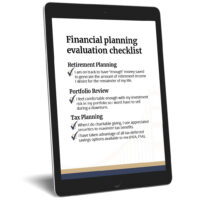
Is your endowment advisor really an advisor?
8 key indicators to know if you’ve outgrown your investment professional or never really had an endowment advisor
Endowment funds serve as critical financial resources for non-profit institutions such as foundations and universities, providing long-term stability and growth of funding to support their missions. Managing an endowment fund requires a delicate balance between protecting the principal or corpus, creating prudent levels of spending and maximizing growth over time. A strong relationship with a skilled financial advisor specialized in endowment process and strategy is essential to maintaining this balance. But how do you know if your current advisor is sufficiently specialized in endowment process best practices and is meeting the needs of your endowment and your endowment fiduciaries?
Signs that you may need to consider a new financial advisor for your endowment fund
1. Conversations with your advisor are only about investments
Smaller and mid-sized endowments often start with the best intentions and have committee members with valuable experience. However, if those committee members do not yet have specific experience with prudent endowment process best practices, it is common for an organization to hire an “investment manager,” “investment advisor,” “broker” or other investment industry professional under the assumption that they provide endowment process guidance.
If you are only having conversations with your “advisor” about investments, especially with a heavy focus on short-term decisions and/or “tactical” or market timing moves, you may have an experienced investment professional, but you don’t have an endowment advisor.
An endowment advisor will have, at minimum, an annual discussion about spending policy. Specifically, they will share how spending policy links directly to and often drives the asset allocation mix. Without this important input, you may be under-optimizing your spending and investment structure and results. You may also be violating endowment regulatory guidelines.
2. You don’t receive an annual Spending Policy Analysis
Endowments are designed for long-term financial sustainability. A prudent spending policy is a key part of that process for spending and asset allocation decision-making and for providing the necessary documentation that you are complying with endowment regulatory guidelines.
Prudent spending policy requires an analysis that considers sufficiently reasonable and defensible projected returns of different stock/bond mixes, inflation, costs and other variables. This ensures that your “maximum sustainable spending” level does not exceed a prudent level and your endowment avoids corpus erosion over time. Corpus erosion violates endowment regulatory requirements and can damage relationships with donors.
A specialized endowment advisor gathers and considers the relevant data and produces a customized spending policy analysis for your fiduciaries, and then helps your committee evaluate prudent alternatives. And, the right endowment advisor will help you craft a Spending Policy document to help memorialize your spending policy along with a “smoothing formula” to help reduce the variability of your spending relative to market movements.
3. Your advisor’s process isn’t specifically designed to meet UPMIFA requirements
UPMIFA is the Uniform Prudent Management of Institutional Funds Act, enacted in 2006, and adopted by most US states, including California. This uniform law provides guidance on investment decisions and endowment spending for nonprofit organizations. UPMIFA replaced UMIFA (the Uniform Management of Institutional Funds Act of 1972). Most non-profit entities and their endowment funds are subject to one or more of the guidelines of UPMIFA.
However, whether or not an organization or funds are subject to the three different levels of UPMIFA guidelines varies based on which definitions are met. UPMIFA has rules and restrictions, depending on what is applicable to a given fund, and also contains seven factors that need to be considered when developing spending policy. Your endowment advisor’s process should be specifically designed to help you systematically comply with the requirements of UPMIFA.
4. Quarterly reports don’t provide relevant analytics
Endowment investment strategies require patience and a long-term view. Quarterly investment reports should provide:
- portfolio-level performance information,
- “blended” benchmark information, and
- endowment peer group data.
This information will help you confirm that your results are reasonable and appropriate in the context of current market conditions and a long-term perspective.
Other valuable information you will want to see from your endowment advisor includes:
- individual investment managers within the portfolio compared against relevant benchmarks and peer groups,
- reports illustrating your asset allocation relative to the target asset allocation to evaluate the need for rebalancing, especially if rebalancing is not addressed more systematically,
- graphs showing cumulative contributions and disbursements. This helps fiduciaries see how asset values compare to original corpus numbers over time.
5. You are still subject to a retail fee schedule
If your endowment is small and/or began with a retail advisor or other provider, you might still have a retail-level fee schedule. Retail fee schedules are often higher than they look if services do not include the spending policy analysis, UPMIFA process guidance and other key support outlined above. They may not be sufficiently transparent and might include compensation from outside parties (such as investment products) that would constitute a conflict of interest.
A specialized endowment advisor will have an institutional-style, fully transparent fee schedule that is appropriate for different fund sizes. They should receive no other compensation.
6. Your advisor is not a fiduciary advisor
If your advisor does not explicitly agree in writing to act as a fiduciary—committing to prioritize your best interests over their own at all times—you may not be receiving unbiased, prudent advice. Be cautious of agreements that only address fiduciary responsibilities at the beginning of the relationship or include vague language buried in fine print. A qualified endowment advisor should provide a clear, written commitment to act as a fiduciary, fully aligned with your organization, 24/7/365.
7. You have short-term money in long-term investments
Endowments or similar entities, such as quasi- or board-endowed funds, should align their investments with their time horizon, especially when significant spending needs are approaching. For example, funds needed within five years are typically not suited for long-term investment pools due to the risk of market volatility. An experienced endowment advisor can help determine when to use one or more short-term investment portfolios, ensuring the investments are tailored to match the anticipated spending timeline.
8. You don’t have clear investment policy or an Investment Policy Statement
Some endowment fiduciaries lack clear communication and guidelines with their investment professional, or they allow the advisor to set the portfolio’s asset allocation without conducting proper analyses or consulting the endowment’s committee. This approach can result in unwelcome surprises, such as excessive or insufficient investment volatility that misaligns with your goals.
A qualified endowment advisor will work with you to develop a thoughtful investment policy by analyzing risk, return, and potential “range of returns” relative to your organization’s goals and spending policy. They will also ensure this policy is documented in a comprehensive Investment Policy Statement.
Get the endowment advice you deserve to fulfill your mission
If any of these issues sounds familiar, it might be time to reassess your relationship with your endowment’s financial advisor. Managing an endowment requires a level of expertise and attention to detail that not every advisor can provide. If you’re considering a change, or you want an evaluation of your current engagement, we’re here to help.
At The Advisory Group, we specialize in endowment planning and management and understand the unique challenges that fiduciaries and their institutions face in balancing mission-driven goals with financial sustainability. Our experienced team is ready to provide the guidance and insight your organization needs to achieve long-term financial health. Schedule a consultation today.
The information provided herein is for informative and educational purposes only. The use of hyperlinks to third party websites is not an endorsement of the third party. Third party content has not been independently verified. To understand how this content may apply to you, please contact a financial advisor.






